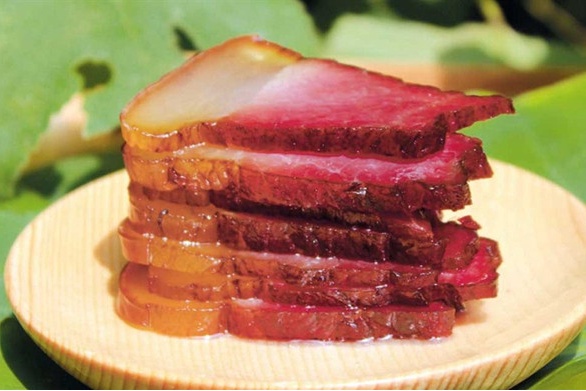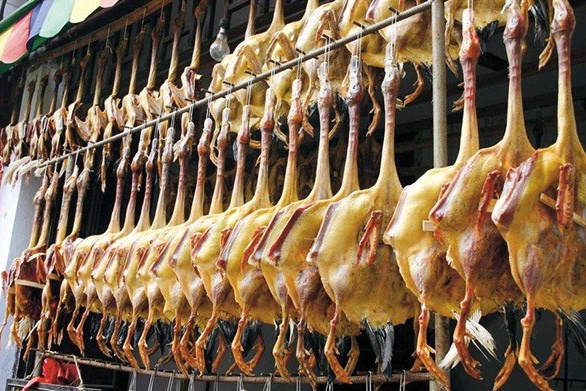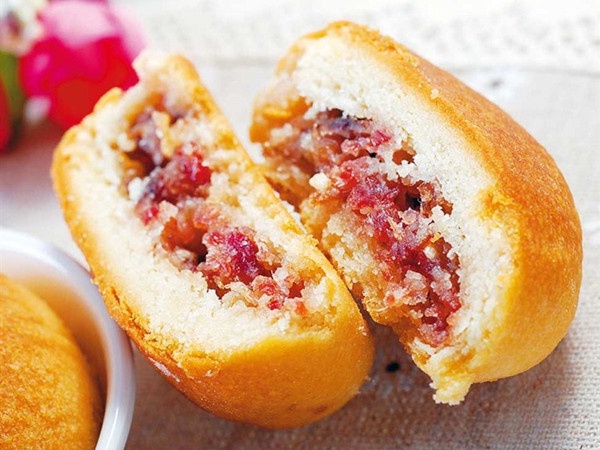
Stocking up on meats, sweets and wines for the Chinese New Year is part of the fun of the holiday. The Year of the Rooster starts on January 28.
To be fully prepared for the most important festival and family reunion of the year, Chinese households usually start their shopping weeks in advance. A proper nian ye fan, or New Year's Eve dinner, requires trips to wet markets and specialty stores like nan huo dian, which feature southern Chinese delicacies.
One of the top items on shopping lists is cured and preserved meat — from opulent whole hams to salty ducks.
About la rou
In Chinese, preserved meat is commonly referred to as la rou because la also refers to the month of December on the lunar calendar. Phonetically, the character should be pronounced xi, meaning of sun-dried after curing, but la is the more commonly acceptable usage.
In ancient times, preserving meat was more of a necessity than a holiday whim. Without refrigeration, people cured fish and meat in large amounts of salt to prevent decomposition and make transport easier. La rou was already part of the Chinese cuisine 2,000 years ago.
The two main methods of preserving meats in China are similar to those in the West: smoking or curing with salt. The techniques can be applied to raw, partially raw or even cooked meats for added flavor and enhanced texture.
Sichuan, Hunan and Guangdong provinces are major meat-preserving areas, each with its own regional recipes. The meats are cured in brine before being smoked or sun-dried, and dry aging can take several months.
In Hunan, preserved meat is a specialty. Pork belly la rou is often stir-fried with seasonal vegetables like bamboo shoots, peppers and garlic shoots.
The Sichuan-style of preserved meat is either smoked or sun-dried, with peppercorns in seasoning, while the sweeter Cantonese style of Guangdong dries the meat without smoking.
Processed meats like bacon, sausages and hams have high levels of fat and sodium nitrate, so people with high risk of heart disease should partake sparingly.

The pork
Pork is the most common base of preserved meat in China. The legs of the pig are reserved for the more expensive whole hams, and high-quality belly meat is used in making strips of la rou. Fatty and lean meat can be minced and made into sausages, and even the pig's head can be cured as a whole.
Ham is regarded the premier cut.
The most famous Chinese hams are produced in Jinhua in Zhejiang Province, Xuanwei in Yunnan Province and Rugao in Jiangsu Province. The pig's hind legs undergo dozens of complicated steps, from shaping and curing to dry aging and packaging. The ham is sold either whole or in slices.
Ham braised in honey sauce, or mi zhi huo fang, is a traditional delicacy cooked with Jinhua ham. One cut of ham, with skin and lotus seeds, is steamed and then braised in sweet sauce. The texture of the ham softens after hours in a steamer with Shaoxing wine and rock sugar. The ham, so rich in flavors, is often cooked with the less flavorful ingredients like sea cucumber and winter melon.
In Yunnan, ham is also used as a filling for mooncakes with hard crusts.
The variety of sausages, or la chang, across China are many. Families often have their special recipes, handed down through generations.
The most popular varieties include the Cantonese-style la chang, which is fattier and sweeter, and the spicy Sichuan style seasoned with chili and peppercorn powder. Xue chang is a blood sausage made with either pig or sheep blood.
In Shanghai, Shanlin brand hong chang, or red sausage, has a special place in the people's hearts. The large, red sausage is a variation of the smoked red sausage produced in Harbin in Heilongjiang Province. Instead of being smoked and boiled, the Shanghai-style red sausage is steamed, chilled and packaged. The vibrant red color comes from natural red yeast, and the lighter taste makes the meat suitable for serving as starter dish or cooked in Shanghai-style borscht.

The poultry
Poultry is the next popular variety of preserved meat.
Ban ya is a term used to describe several kinds of cured duck produced across China. The name is translated as "flat duck" because of its board-like shape.
In Nanjing, there are two types of ban ya. One is made in winter and the other in summer. The ducks are cleaned, cured in salt and special brine, and then steamed. The ducks are not preserved and must be eaten soon.
In places like Shifang in Sichuan, Gaotai in Anhui Province and Jian'ou in Fujian Province, the ducks are cured and dried for longer preservation. Dried ban ya can be steamed and served as is or added to stews with vegetables like bamboo shoots and radish.
The best way to enjoy ban ya is simply steaming the whole duck after soaking it in warm water for 30 minutes. The texture softens, releasing the rich flavors from the curing process.
Chicken are cured and preserved in a similar method to ducks, either smoked or sun-dried.
The beef and lamb
Cured pork is more popular in southern China, whereas northerners often prefer cured beef and lamb.
Cured beef (la niurou) and lamb (la yangrou) are specialties of Xi'an in Shaanxi.
They are popular dishes for the New Year's Eve dinner. The beef or lamb is cured in a brine for several days and then cooked and served directly as a cold starter or in a sandwich-style meat stuffing called bai ji mo.

Cooking with cured meats
Because cured meats last through even the hottest days of summer, they are often kept in stock in home kitchens.
When buying cured meats, it's important to note texture, color and smell. Good preserved meat has crimson-colored lean meat, clear or cream-colored fat, a dry surface and good elasticity.
It's important to buy the meat from reputable vendors to ensure that it doesn't contain industrial salt and non-food coloring.
Other than sausages, which can be steamed or sliced and stir-fried directly, most cured meat should go through extra steps before being added to dishes to eliminate extra fat, grease and salt.
Soaking preserved meat in warm water or boiling it in hot water for 5 minutes are quick methods to do that. Steaming with a bit of cooking wine, water, scallions and ginger before slicing and further cooking is a slower method that retains the flavors.



